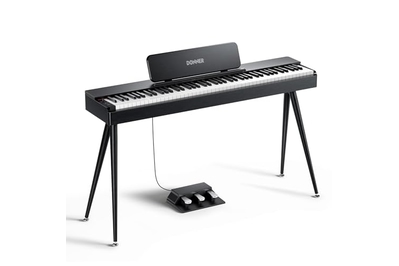The 3 Best Budget Digital Piano for Beginners of 2025

The Donner Oura S100 is an excellent alternative to the Roland FP-10 for anyone who wants a quality piano with legs. Not only is the Oura S100 less expensive than our other picks, but it includes a high-quality triple pedal that gives you the same performance options you’d get on an acoustic piano. The action feels similar to that of an acoustic piano, and at least half of the 15 included sounds are very good.
It’s more like a piece of furniture. The Oura S100 is made from fiberboard covered with faux-wood vinyl, and it includes tapered metal legs that attach to the bottom. So it looks more like a permanent resident of a living room than like something you set up temporarily.
At 35.8 pounds for the piano and an additional 8.6 pounds for the legs, it’s heavier and much less portable than our other picks, although still light enough that one person can move it fairly easily.
The supplied music stand is also made of vinyl-covered fiberboard, so it’s stiffer and sturdier than the plastic music stands included with other digital pianos.
The action is a bit lighter and less realistic than that of our top pick. Donner calls the Oura S100’s action “graded hammer weighted action,” and it allows the keyboard to better emulate how the action feels across an acoustic piano’s keyboard, where the lower notes are a bit heavier than the higher notes. It doesn’t have the Roland FP-10’s escapement simulation, but it’s a little more responsive and easier on the fingers. The action is a little heavier here than on the Casio CDP-S360.
The Oura S100 also includes a high-quality triple pedal, which works the same way as the pedals on an acoustic piano. In addition to the sustain function included with our other picks, there’s a soft pedal (which reduces the volume and softens the tone a bit) and a sostenuto pedal, which sustains only notes that were already ringing when you pressed the pedal. Our Roland pick is not compatible with triple pedals, and triple pedals are an extra-cost option on the Casio pick.
One other difference is that the Oura S100’s plastic keys do not have the subtle texturing found on the Roland and Casio picks. Some of our testers preferred the other pianos’ texturing, but none considered this feature to be a deciding factor.
It has 15 sounds, and many are good. The Oura S100 includes several sounds we liked, including two of a grand piano, three of an electric piano, one jazz organ, an acoustic bass, and a nice combination of grand piano with electric piano.
Its orchestral-string sounds seemed a little cheesy to us, though. Also, the guitar sounds might have been able to double as useful clavinet sounds, but they added string-scraping noise to random notes, which we consider a musically questionable choice, to say the least.
This piano includes a few convenient features. It has a built-in Bluetooth receiver, so you can play music from your phone through the piano’s speakers. The back panel has quarter-inch audio inputs and outputs, plus a USB Type-B jack that lets the Oura S100 double as a MIDI controller. There are two quarter-inch headphone outputs. The volume control is a simple knob at the left end of the keyboard that’s easy and quick to adjust.
Flaws but not dealbreakers
Some of the controls and jacks are inconvenient. Selecting a sound is simple — just press the Function button at the left end of the keyboard, then press one of the 15 keys that the sounds are assigned to. However, the keys are not labeled, so you have to memorize which ones you like, consult the table in the back of the manual, or maybe put some painter’s tape across the top of the piano and write the names of the sounds on it.
Also, the dual headphone jacks are on the bottom, near the front left corner. You can find them by feel, and you could argue that having them near the front is more convenient than having them on the back panel, but we would appreciate some visual indicator of where they are.
The S100 is missing some features. You can’t split the keyboard in two so that a student and teacher can play together. It also lacks a metronome function, which most digital pianos have — although free smartphone apps can provide a more fully featured and easily adjustable metronome.
While Donner does provide the Donner Music app (which offers 36 digital piano lessons), the app doesn’t add features or control capabilities, or interface with the piano in any way we could find.
It’s not really portable. You’ll probably have to remove the legs to get this piano into a car, and its fiberboard cabinet is heavier than the plastic enclosures used on most digital pianos.







